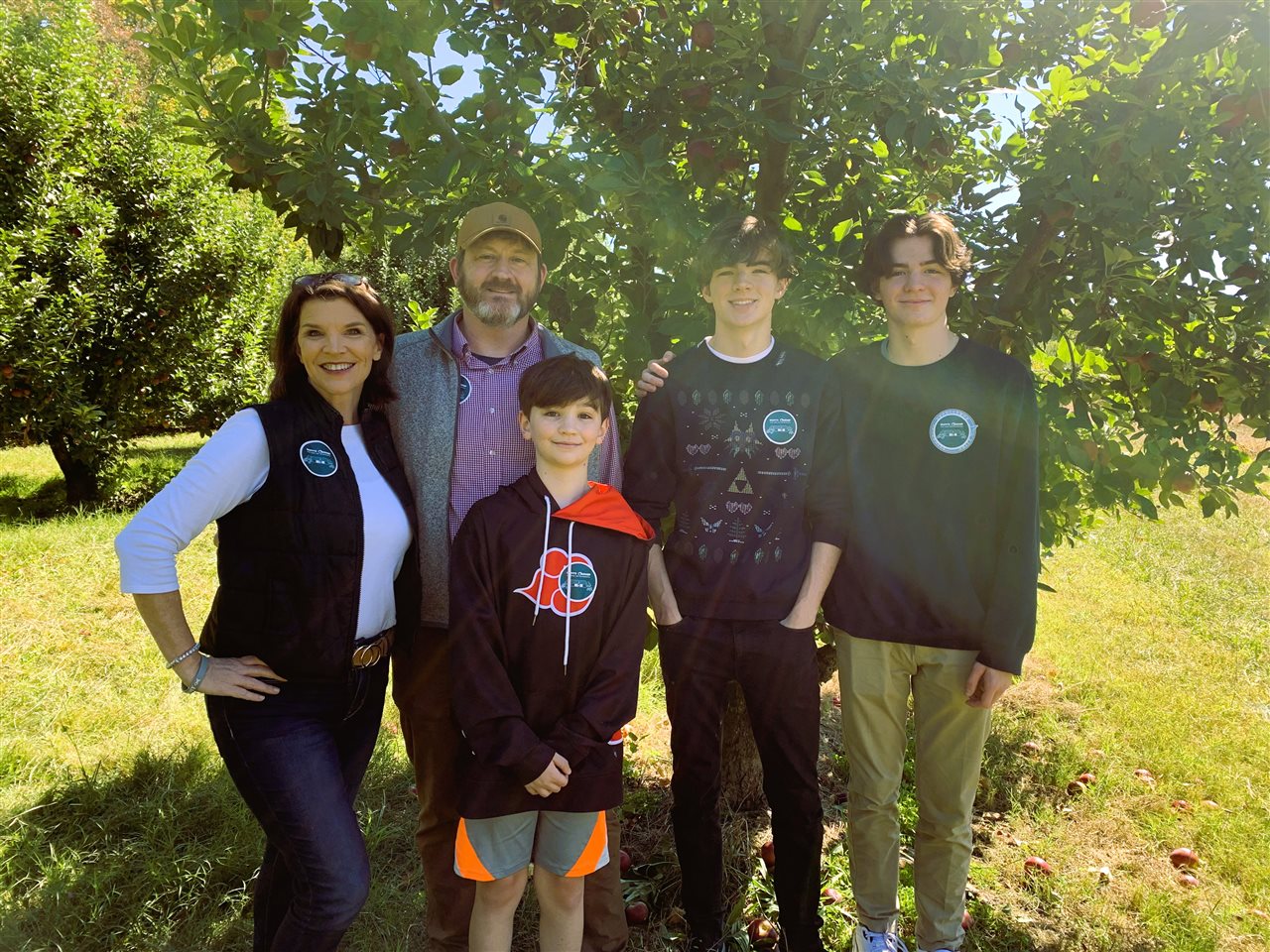Living Boldly with Glioma: Jennifer’s Story of Resilience
Posted: September 30, 2024 | Word Count: 1,966

One woman shares her story of hope living with a rare and aggressive brain cancer.
Jennifer’s* story begins in a small town in Alabama where she was born into a loving family. From a very young age, it was clear that she had a tenacious spirit and a fierce determination to make the most of her life.
She excelled academically, poured her heart into sports, and always aimed to better herself and those around her. With a clear vision for her future, she aspired to become an attorney. Marriage and children were not part of her plan.
"I always said I was never going to get married or have kids. I was going to be a lawyer and help people who couldn't help themselves," Jennifer said. "But life had other plans for me."
She met a man who completely captured her heart. They got married, and together they built a beautiful life. She ended up changing her career path, earning an MBA instead of a law degree, and her husband secured a job as an engineer. Together, they built their family by having three boys. They instilled in their children the values of volunteerism and community, creating a nurturing and enriching family environment.
Their life was vibrant and fulfilling, with every day bringing new joys and challenges. But in 2015, when Jennifer was 40 years old and her children were ages 11, 8 and 4, their journey took an unexpected turn. One day, Jennifer felt what she described as "off" and looked in the mirror to find that half her face was paralyzed. She brushed it off and told her husband she was going to see a nurse practitioner. What seemed like what she called a "minor inconvenience" turned into a whirlwind of events as Jennifer was advised to go to the emergency room immediately.
"I remember thinking, 'I don't have a stroke. I just ran a 5K that morning. I have a meeting to attend,'" Jennifer recalls. "But when I got to the ER, things got serious quickly."
At the ER, it was discovered that Jennifer had a lesion on her brain. The news was shocking and surreal. She, a strong and healthy person who lived life at full speed, couldn't fathom having a possible brain tumor. But reality set in. Despite the gravity of the situation, Jennifer remained positive and determined.
"I couldn't believe it," Jennifer said. "Me? A brain tumor? It seemed impossible."
Through a surgical resection, the lesion was identified as glioma, a rare brain cancer. She later found out that she had a specific type of glioma with an IDH-mutation.

Jennifer and her family before her diagnosis.
"A glioma is a type of tumor that develops in the brain or spinal cord. The overwhelming majority of all primary malignant brain tumors are gliomas," said Dr. Rimas V. Lukas, a neuro-oncologist and Associate Chief of Neuro-Oncology, Northwestern Feinberg School of Medicine. Note, Dr. Lukas was not Jennifer's healthcare provider. "Of those, approximately 20 percent harbor what's known as a mutation in the genes encoding isocitrate dehydrogenase, or IDH."
IDH-mutant gliomas are malignant and incurable brain tumors that continue to grow and relentlessly infiltrate the brain, even after surgery. Symptoms of glioma vary from patient to patient and are influenced by tumor type and location. Both before and after a glioma diagnosis, patients may experience a wide range of symptoms including changes in mental function, speech difficulties, new weakness or numbness in one or more body parts, seizures, headache, nausea and vomiting.
"IDH-mutant glioma is a relatively overlooked and generally understudied patient population," added Dr. Lukas. "Approximately 2,400 patients a year are diagnosed with this aggressive cancer, but there are likely many living with these tumors, either receiving active treatment or being followed clinically and radiographically on what physicians call a 'watch and wait,' or active surveillance, protocol."
Jennifer's journey took her out of her local hospital and into a larger one in a nearby city, where she met her neuro-oncologist for the first time. Her neuro-oncologist was a true partner to her from the start and someone who she described as "patient, treated me with respect and cared about who I was as a person." He confirmed the diagnosis because of her age and extensive surgical resection, and instead of prescribing immediate radiation and chemotherapy, placed her on a "watch and wait" protocol. For her, this meant regular MRIs and close monitoring of the tumor's progression before considering more aggressive forms of treatment.
During this journey, she reconnected with Tara, a former colleague and mother of four daughters, who, coincidentally, had also been diagnosed with a rare brain cancer and was seeking treatment at the same hospital as Jennifer. Tara and Jennifer became each other's pillars of support. They turned doctor visits into opportunities for camaraderie, sharing laughs and tears along the way.
"Tara and I became each other's rock," Jennifer explains. "We turned hospital visits into moments of strength and support, knowing we were in this together."
Jennifer's outlook on life changed. She focused on creating memories with her children, ensuring they always remembered her as a loving and fun mother. She took them on trips, engaged in activities they loved, and lived each day to the fullest. She also made practical decisions, ensuring her family's future was secure financially.
"I took my kids on every adventure I could think of," Jennifer says. "From road trips to the beach to visiting zoos, I wanted to create as many memories as possible."
As the days passed, the reality of her condition weighed heavily on Jennifer, but her spirit remained unbroken. Jennifer had a Grade 2 glioma, and the time had come for her to consider more aggressive treatment options.
Jennifer vividly remembers the day she was about to start radiation. As she was being prepped, a nurse suddenly entered the room, bringing everything to a halt.
Wait," the nurse said urgently. "The doctor has news for you."
The doctor told Jennifer about a new trial, INDIGO, specifically designed for patients with IDH-mutant gliomas.
The INDIGO trial was investigating a new oral therapy at the time, Voranigo® (vorasidenib).
See below for additional Important Safety Information, including the benefits and risks of Voranigo® (vorasidenib). Click here for Prescribing Information and discuss with your doctor.
With her neurooncologist's guidance and an understanding of the benefits and risks of Voranigo, Jennifer quickly enrolled in the INDIGO study.
"I was both excited and nervous," Jennifer recalled.
The journey was challenging, but Jennifer's unwavering determination and the support of her loved ones carried her through.
While Jennifer was participating in the clinical trial, her friend Tara faced her own challenges. Tara's condition worsened, and she did not survive the cancer. Jennifer was heartbroken by the loss of her friend but continued to draw strength from the bond they had shared.
"Tara's passing was a profound loss," Jennifer said. "She was my rock, and I miss her every day. But her memory drives me to keep fighting and to live fully."
Today, Jennifer’s brain tumor progression has slowed.

"Every day, I feel grateful," Jennifer said. "Life is precious, and I'm determined to make the most of every moment. I dream of holding my future grandchildren one day. Despite my condition, I’m thinking about the adventures ahead and hope to take a Mediterranean vacation with my husband soon."
Dr. Lukas stated: "We are now entering a new era in the treatment of IDH-mutant gliomas, with the recent approval of the first targeted therapy for this patient population."
Voranigo, which was approved in the U.S. on August 6, 2024, is an isocitrate dehydrogenase-1 (IDH1) and isocitrate dehydrogenase-2 (IDH2) inhibitor, indicated for the treatment of adult and pediatric patients 12 years and older with Grade 2 astrocytoma or oligodendroglioma with a susceptible IDH1 or IDH2 mutation following surgery including biopsy, subtotal resection, or gross total resection.
The approval of Voranigo is supported by results from the pivotal Phase 3 INDIGO clinical trial published in The New England Journal of Medicine and presented at the 2023 ASCO plenary, which showed that Voranigo significantly extended progression-free survival and time-to-next intervention, when compared to placebo.
“There are benefits and risks associated with Voranigo. It is important for patients to speak with a doctor to learn more,” said Dr. Lukas.
For more information about Voranigo, please visit www.Voranigo.com.
*Jennifer is a paid consultant for Servier in the U.S. Last name withheld to protect personal privacy.
**Dr. Rimas Lukas is a paid consultant for Servier in the U.S.
What is VORANIGO?
VORANIGO (40 mg tablets) is a prescription medicine used to treat adults and children 12 years of age and older with certain types of brain tumors called astrocytoma or oligodendroglioma with an isocitrate dehydrogenase-1 (IDH1) or isocitrate dehydrogenase-2 (IDH2) mutation, following surgery. Your healthcare provider will perform a test to make sure that VORANIGO is right for you. It is not known if VORANIGO is safe and effective in children under 12 years of age.
What are the possible side effects of VORANIGO?
VORANIGO may cause serious side effects, including:
- Liver problems. Changes in liver function blood tests may happen during treatment with VORANIGO and can be serious. Your healthcare provider will do blood tests to check your liver function before and during treatment with VORANIGO. Tell your healthcare provider right away if you develop any of the following signs and symptoms of liver problems:
- yellowing of your skin or the white part of your eyes (jaundice) dark tea-colored urine
- loss of appetite
- pain on the upper right side of your stomach area feeling very tired or weak
The most common side effects of VORANIGO include:
- increased liver enzyme levels in the blood
- lack of energy, tiredness
- headache
- COVID-19
- muscle aches or stiffness
- diarrhea
- nausea
- seizure
Your healthcare provider may change your dose, temporarily stop, or permanently stop treatment with VORANIGO if you have certain side effects.
VORANIGO may affect fertility in females and males, which may affect the ability to have children. Talk to your healthcare provider if this is a concern for you.
These are not all of the possible side effects of VORANIGO.
Before taking VORANIGO, tell your healthcare provider about all of your medical conditions, including if you:
- have liver problems
- have kidney problems or are on dialysis
- smoke tobacco
- are pregnant or plan to become pregnant. VORANIGO can harm your unborn baby
Females who are able to become pregnant:
- Your healthcare provider will do a pregnancy test before you start treatment with VORANIGO
- You should use effective nonhormonal birth control during treatment with VORANIGO and for 3 months after the last dose. VORANIGO may affect how hormonal contraceptives (birth control) work and cause them to not work well. Talk to your healthcare provider about birth control methods that may be right for you during treatment with VORANIGO
- Tell your healthcare provider right away if you become pregnant or think you may be pregnant during treatment with VORANIGO
Males with female partners who are able to become pregnant:
- You should use effective birth control during treatment with VORANIGO and for 3 months after the last dose
- Tell your healthcare provider right away if your partner becomes pregnant or thinks she may be pregnant during your treatment with VORANIGO
Tell your healthcare provider if you are breastfeeding or plan to breastfeed. It is not known if VORANIGO passes into breast milk. Do not breastfeed during treatment with VORANIGO and for 2 months after the last dose.
Tell your healthcare provider about all the medicines you take, including prescription and over-the-counter medicines, vitamins, and herbal supplements. VORANIGO may affect the way other medicines work, and other medicines may affect how VORANIGO works.
Please see Full Prescribing Information.
Includes Multiple Photos



